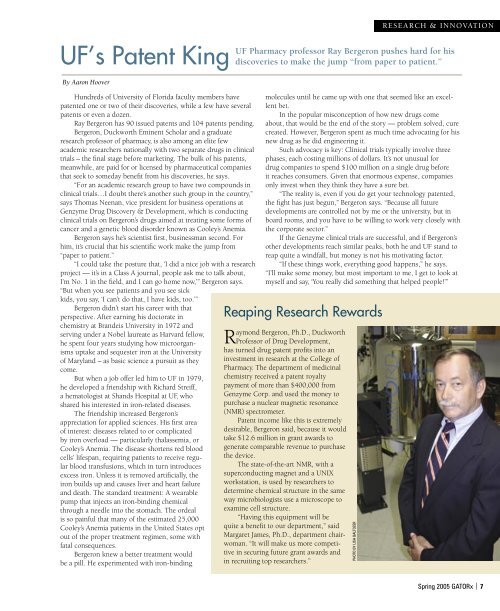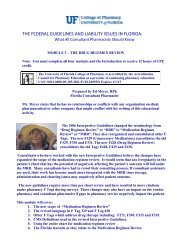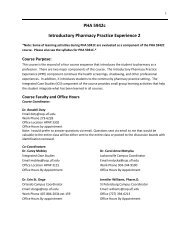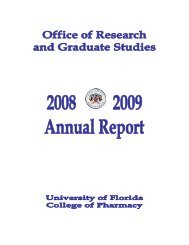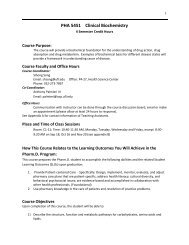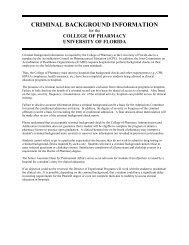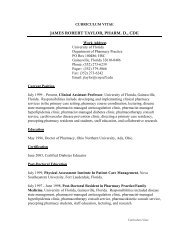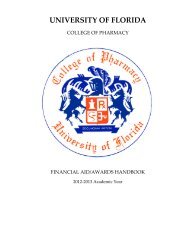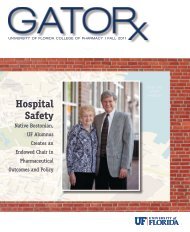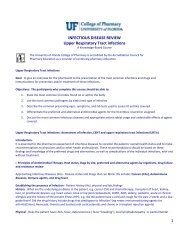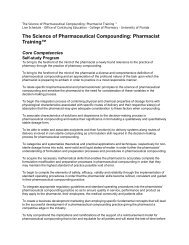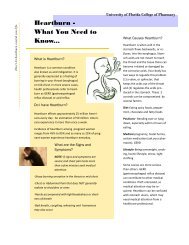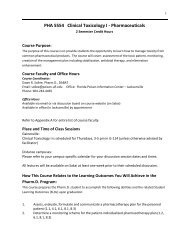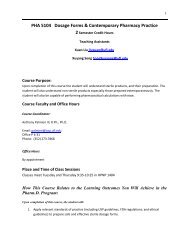GATORx W05.indd - College of Pharmacy - University of Florida
GATORx W05.indd - College of Pharmacy - University of Florida
GATORx W05.indd - College of Pharmacy - University of Florida
You also want an ePaper? Increase the reach of your titles
YUMPU automatically turns print PDFs into web optimized ePapers that Google loves.
UF’s Patent King<br />
By Aaron Hoover<br />
Hundreds <strong>of</strong> <strong>University</strong> <strong>of</strong> <strong>Florida</strong> faculty members have<br />
patented one or two <strong>of</strong> their discoveries, while a few have several<br />
patents or even a dozen.<br />
Ray Bergeron has 90 issued patents and 104 patents pending.<br />
Bergeron, Duckworth Eminent Scholar and a graduate<br />
research pr<strong>of</strong>essor <strong>of</strong> pharmacy, is also among an elite few<br />
academic researchers nationally with two separate drugs in clinical<br />
trials – the final stage before marketing. The bulk <strong>of</strong> his patents,<br />
meanwhile, are paid for or licensed by pharmaceutical companies<br />
that seek to someday benefit from his discoveries, he says.<br />
“For an academic research group to have two compounds in<br />
clinical trials…I doubt there’s another such group in the country,”<br />
says Thomas Neenan, vice president for business operations at<br />
Genzyme Drug Discovery & Development, which is conducting<br />
clinical trials on Bergeron’s drugs aimed at treating some forms <strong>of</strong><br />
cancer and a genetic blood disorder known as Cooley’s Anemia.<br />
Bergeron says he’s scientist first, businessman second. For<br />
him, it’s crucial that his scientific work make the jump from<br />
“paper to patient.”<br />
“I could take the posture that, ‘I did a nice job with a research<br />
project — it’s in a Class A journal, people ask me to talk about,<br />
I’m No. 1 in the field, and I can go home now,’” Bergeron says.<br />
“But when you see patients and you see sick<br />
kids, you say, ‘I can’t do that, I have kids, too.’”<br />
Bergeron didn’t start his career with that<br />
perspective. After earning his doctorate in<br />
chemistry at Brandeis <strong>University</strong> in 1972 and<br />
serving under a Nobel laureate as Harvard fellow,<br />
he spent four years studying how microorganisms<br />
uptake and sequester iron at the <strong>University</strong><br />
<strong>of</strong> Maryland – as basic science a pursuit as they<br />
come.<br />
But when a job <strong>of</strong>fer led him to UF in 1979,<br />
he developed a friendship with Richard Streiff,<br />
a hematologist at Shands Hospital at UF, who<br />
shared his interested in iron-related diseases.<br />
The friendship increased Bergeron’s<br />
appreciation for applied sciences. His first area<br />
<strong>of</strong> interest: diseases related to or complicated<br />
by iron overload — particularly thalassemia, or<br />
Cooley’s Anemia. The disease shortens red blood<br />
cells’ lifespan, requiring patients to receive regular<br />
blood transfusions, which in turn introduces<br />
excess iron. Unless it is removed artificially, the<br />
iron builds up and causes liver and heart failure<br />
and death. The standard treatment: A wearable<br />
pump that injects an iron-binding chemical<br />
through a needle into the stomach. The ordeal<br />
is so painful that many <strong>of</strong> the estimated 25,000<br />
Cooley’s Anemia patients in the United States opt<br />
out <strong>of</strong> the proper treatment regimen, some with<br />
fatal consequences.<br />
Bergeron knew a better treatment would<br />
be a pill. He experimented with iron-binding<br />
UF <strong>Pharmacy</strong> pr<strong>of</strong>essor Ray Bergeron pushes hard for his<br />
discoveries to make the jump “from paper to patient.”<br />
molecules until he came up with one that seemed like an excellent<br />
bet.<br />
In the popular misconception <strong>of</strong> how new drugs come<br />
about, that would be the end <strong>of</strong> the story — problem solved, cure<br />
created. However, Bergeron spent as much time advocating for his<br />
new drug as he did engineering it.<br />
Such advocacy is key: Clinical trials typically involve three<br />
phases, each costing millions <strong>of</strong> dollars. It’s not unusual for<br />
drug companies to spend $100 million on a single drug before<br />
it reaches consumers. Given that enormous expense, companies<br />
only invest when they think they have a sure bet.<br />
“The reality is, even if you do get your technology patented,<br />
the fight has just begun,” Bergeron says. “Because all future<br />
developments are controlled not by me or the university, but in<br />
board rooms, and you have to be willing to work very closely with<br />
the corporate sector.”<br />
If the Genzyme clinical trials are successful, and if Bergeron’s<br />
other developments reach similar peaks, both he and UF stand to<br />
reap quite a windfall, but money is not his motivating factor.<br />
“If these things work, everything good happens,” he says.<br />
“I’ll make some money, but most important to me, I get to look at<br />
myself and say, ‘You really did something that helped people!’”<br />
Reaping Research Rewards<br />
Raymond Bergeron, Ph.D., Duckworth<br />
Pr<strong>of</strong>essor <strong>of</strong> Drug Development,<br />
has turned drug patent pr<strong>of</strong>its into an<br />
investment in research at the <strong>College</strong> <strong>of</strong><br />
<strong>Pharmacy</strong>. The department <strong>of</strong> medicinal<br />
chemistry received a patent royalty<br />
payment <strong>of</strong> more than $400,000 from<br />
Genzyme Corp. and used the money to<br />
purchase a nuclear magnetic resonance<br />
(NMR) spectrometer.<br />
Patent income like this is extremely<br />
desirable, Bergeron said, because it would<br />
take $12.6 million in grant awards to<br />
generate comparable revenue to purchase<br />
the device.<br />
The state-<strong>of</strong>-the-art NMR, with a<br />
superconducting magnet and a UNIX<br />
workstation, is used by researchers to<br />
determine chemical structure in the same<br />
way microbiologists use a microscope to<br />
examine cell structure.<br />
“Having this equipment will be<br />
quite a benefit to our department,” said<br />
Margaret James, Ph.D., department chairwoman.<br />
“It will make us more competitive<br />
in securing future grant awards and<br />
in recruiting top researchers.”<br />
PHOTO BY LISA BALTOZER<br />
RESEARCH & INNOVATION<br />
Spring 2005 <strong>GATORx</strong> | 7


